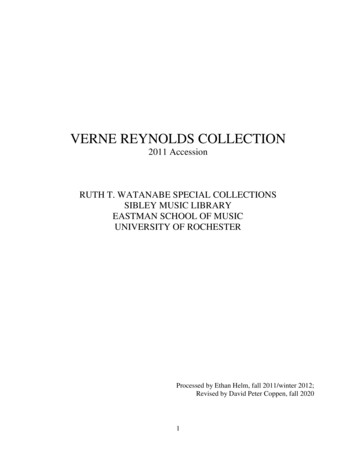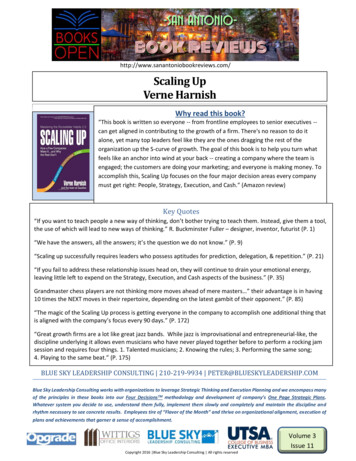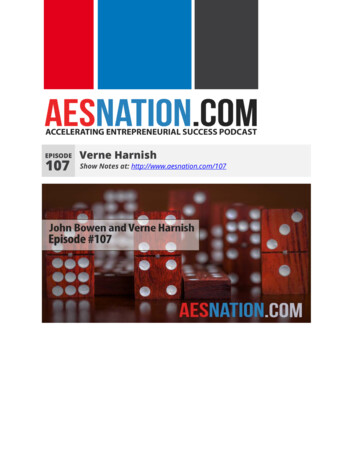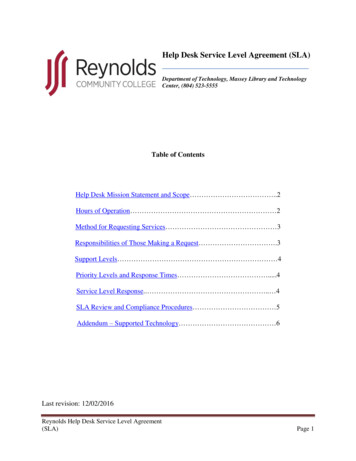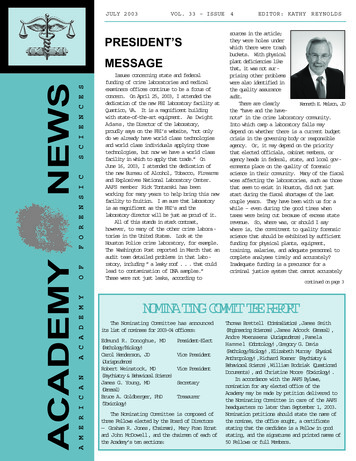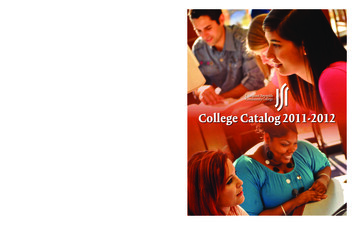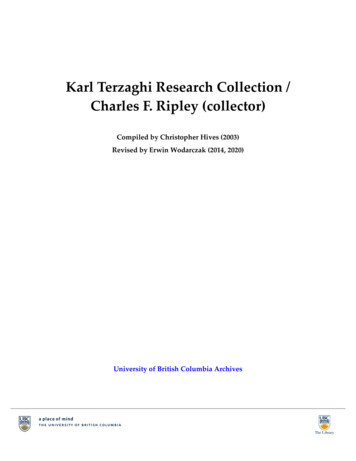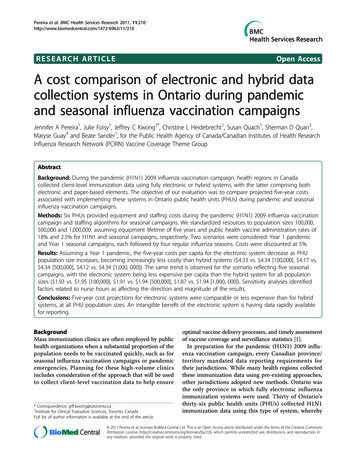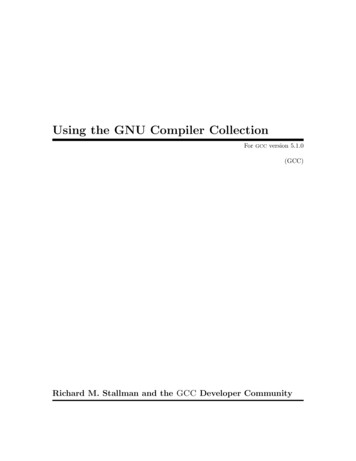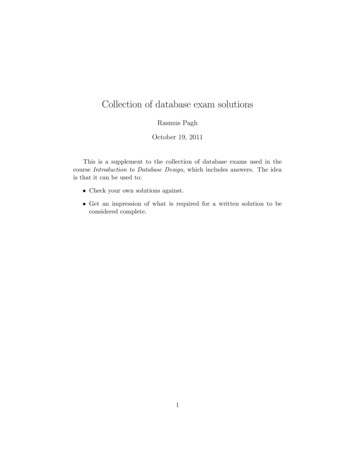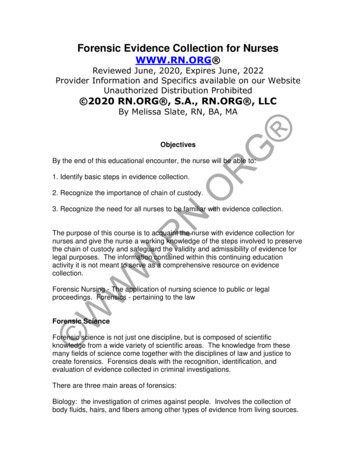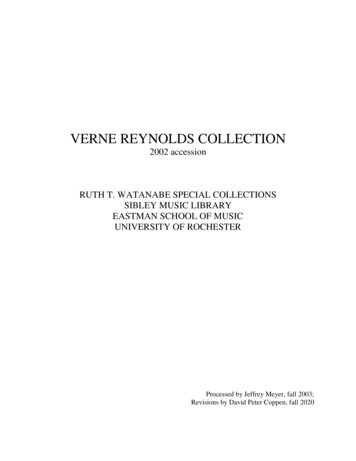
Transcription
VERNE REYNOLDS COLLECTION2002 accessionRUTH T. WATANABE SPECIAL COLLECTIONSSIBLEY MUSIC LIBRARYEASTMAN SCHOOL OF MUSICUNIVERSITY OF ROCHESTERProcessed by Jeffrey Meyer, fall 2003;Revisions by David Peter Coppen, fall 2020
Verne Reynolds with unidentified student. Photograph from ESPA 34-41 (photo 2) (8x10).2
TABLE OF CONTENTSDescription of Collection.4Description of Series .7Series 1: Original Works, Arrangements, and Transcriptions.8Series 2: Papers: Performing and Academic Life.21Series 3: Sound Recordings .24Series 4: Oversized Materials.27INVENTORY3
DESCRIPTION OF COLLECTIONShelf location: C3B 4,5Physical extent: 6 linear feetBiographical sketch(Left) Photograph by Louis Ouzer, from Verne Reynolds Collection (2002), Box 8, Folder 2, Sleeve 7; see also ESPA 34-36 (8x10);(Right) Photograph from Verne Reynolds Collection (2002), Box 8, Folder 1, Sleeve 1; see also ESPA 6-48 (5x7).Born on July 18, 1926, in Lyons, Kansas, Verne Reynolds began his musical studies onthe piano at age eight and on the horn at age 13. After finishing high school he enlisted in the USNavy for service during World War II. Following his discharge in 1946, Mr. Reynolds enrolledin the Cincinnati Conservatory of Music, where he studied composition. He was a member of theCincinnati Symphony for three years (1947-50) and also taught in the Conservatory for one year(1949-50). He received his bachelor’s degree in 1950 and went on to earn a master’s degree atthe University of Wisconsin-Madison in 1951. He taught at the University of WisconsinMadison for three years (1950-53). Thereafter, he travelled to England on a Fulbright fellowshipfor one year’s study (1953-54) at the Royal College of Music (London), where he studied undersuch distinguished figures as composer Herbert Howells. During his year in London, Mr.Reynolds also performed under conductors as Sir Malcolm Sargent and Sir Thomas Beecham.On his return to the United States in 1954, Mr. Reynolds was appointed to the faculty of IndianaUniversity (Bloomington). In 1959, he was appointed to the faculty of the Eastman School ofMusic, where he would continue teaching until his retirement in 1995. Concurrent with hisfaculty appointment, Mr. Reynolds joined the Rochester Philharmonic Orchestra as principalhornist, a position he would hold until 1968.4
A respected composer, Mr. Reynolds’ output numbered more than 60 published works,issued by such publishers as G. Schirmer, Carl Fischer, Belwin-Mills, and Southern Music. Hereceived commissions from chamber groups, instrumental soloists, large ensembles, and schoolsof music; these included the Louisville Orchestra, the Cincinnati Symphony Orchestra, theInternational Horn Society, Lawrence University, the Los Angeles Horn Club, Michigan StateUniversity, and trumpeter-bandleader Doc Severinsen. Significantly, the Eastman School ofMusic recognized him with commissions for new works in honor of the school’s 50th and 75thanniversaries. Within the international French horn community, Mr. Lawrence continues to becelebrated for his technically challenging 48 Etudes (first published in 1961 by G. Schirmer) andfor his substantive textbook The Horn Handbook (Amadeus Press, 1996). Apart from his originalworks, his transcriptions of Renaissance music and Baroque music for brass quintet and for hornchoir have been particularly well received. Recordings of his music have been issued on the Vox,Crystal, CRI, and Mark labels.As a performer, Mr. Reynolds was a founding member of the Eastman Brass, a quintetcomprised of Eastman School faculty members. The Eastman Brass contributed mightily toheightening the popularity of the medium of the brass quintet through its public performancesand recordings. Earlier in his career, he had also performed with the American WoodwindQuintet.Among Mr. Reynolds’ numerous awards were the Rochester Alumni Citation (1973), theASCAP Publication Award, the Los Angeles Horn Club award, and the Louisville Orchestraaward (1955). His first published composition, Theme and Variations for brass choir, wasawarded the 1950 Thor Johnson Brass Award. In 1994, he was named an Honorary Member ofthe International Horn Society for his contributions at the international level to the art of hornplaying. Upon Mr. Reynolds’ retirement from the Eastman School of Music in 1995, theUniversity of Rochester conferred upon him the status of professor emeritus.He died on June 28, 2011 in Rochester, New York.ProvenanceThe collection was the gift of Professor Reynolds, received by the Sibley Music Libraryin the summer of 2002.Scope and content noteThe collection constitutes a concise body of the musical works of Professor VerneReynolds, together with a small body of his professional papers. Mr. Reynolds’ activity as afounding member of the Eastman Brass are represented in numerous publicity materials,photographs, and sound recordings. Separately, the 2011 accession of Mr. Reynolds’ papersconstitutes a vastly larger body of content, which in particular offers the instrumental parts forthose works represented in the given collection by their scores only.5
Restrictions and useThere are no restrictions on the use of the materials in this collection, save for thoseimposed by the U.S. Copyright Law (1976) and its revisions.AssociationsThe Verne Reynolds collection is one collection among RTWSC’s continually growingcorpus of the professional papers of Eastman School faculty members. Significantly, ProfessorReynolds was the first member of the Eastman Brass to archive his personal papers in the SibleyMusic Library. For wider study of the worldwide professional activity surrounding theinstruction and performance of the French horn, RTWSC holds on deposit the archive of theInternational Horn Society.6
DESCRIPTION OF SERIESThe items in the Verne Reynolds Collection are arranged in series and sub-series asoutlined below:Series 1:Original Works, Arrangements, and TranscriptionsSub-series A: Original works in manuscript and manuscript facsimilesSub-series B: Arrangements and transcriptions in manuscript and manuscript facsimilesSub-series C: Original works in publicationSub-series D: Arrangements and transcription in publicationSub-series E: BooksSeries 2:Papers: Performing and Academic LifeSub-series A: ProgramsSub-series B: CorrespondenceSub-series C: PublicitySub-series D: PhotographsSub-series E: Other items, not elsewhere classifiedSeries 3:Sound RecordingsSub-series A: Audio-cassettesSub-series B: Magnetic reelsSub-series C: Compact discsSeries 4:Oversized materials7
INVENTORYSeries 1:Original Works, Arrangements, and TranscriptionsSub-series A: Original works in manuscript and manuscript facsimilesBox 1folder 148 Etudes for trumpet.Transcribed from the 48 Etudes for French horn.MS repro, bound; 48 pages of music.At head of title page: 1971.folder 2Brass Quintet.Score. MS repro, bound; 23 pages of music.“Commissioned by the Wisconsin Brass Quintet in celebration of its fifteenthanniversary”—on title page.folder 3Calls and Echoes.For two trumpets in C.Score. MS repro, bound; 8 pages of music.At end of score: 1986.folder 4Capriccio.For alto saxophone and piano.MS repro score (10 pages of music) and part (3 pages of music).“Written for Ramon Ricker”—in caption of first page of score.In caption of first page of score: 1978.folder 5Concertare I.For brass quintet and percussion.Score. MS repro; 14 pages of music.At foot of first page of score: 1969 Verne Reynolds.folder 6Concertare IV.For brass quintet and piano.Score. MS repro, bound; 40 pages of music.At end of score: August 1971Performance markings in pencil throughout.folder 7Concertare V.For flute, oboe, clarinet, bassoon, horn, trumpet, trombone and percussion.Score. MS repro, bound;18 pages of music.8
“Commissioned by Baylor University School of Music”—at head of first pageof score.At end of score: July, 1975.folder 8Concerto for Piano and Wind Ensemble.Score. MS repro, bound; 109 pages of music.“Commissioned by the Eastman School of Music, Robert Freeman, Director,to celebrate the 75th anniversary of the school and to honor the EastmanWind Ensemble, Frederick Fennell, Founder and Donald Hunsberger,Conductor”—on title page.At end of score: May, 1996.Engraving and reproduction prepared by Kenneth Richmond.folder 9Echo Variations.For oboe and piano.Score. MS repro, bound; 12 pages of music.“Commissioned by Daniel Stolper”—in caption of first page of music.At end of score: February, 1978.folder 10Fantasy Etudes for Bassoon and Percussion.Score. MS repro, bound; 13 pages of music.At end of score: 11-83.folder 11Fantasy Etudes for Trumpet and Piano.Score. MS repro, bound; 28 pages of music.Trumpet part. MS repro, bound; 13 pages of music.At end of score: January, 1979,1. Capriccio: whimsically, with sudden contrasts. — 2. Accents: as fast asevery note will sound. — Calm: from a great distance, quiescent. — 4.Motion: with humor and care. — 5. Fermatas: with great dynamiccontrasts. — 6. Echoes: transpicuous, precise. — 7. Calls: freely, with asense of ancient signals. — 8. Cavatina: unhurried, vocal, nostalgic. — 9.Speed: as fast as every note will sound. — 10. Chorale: with a solemndignity.Composer’s note: “The complete titles, as above, should be included on recitalprograms. When performing the entire work the Etudes should be playedin the given order. Smaller groups may be combined in any reasonableorder.”— on title page.folder 12Fantasy Etudes, Volume II for Clarinet, Percussion and Piano.Score. MS repro, bound; 22 pages of music.Clarinet part. MS repro, bound; 12 pages of music.Percussion part. MS repro, bound; 10 pages of music.9
“To Kenneth Grant, friend and esteemed colleague”—on title pages of scoreand parts.At end of score: 1990.folder 13Fantasy Etudes, Volume V for Horn and Piano.Score. MS repro, bound; 27 pages of music.Horn part. MS repro, bound; 9 pages of music.At end of score: 1992.folder 14Florilegium, Volume I.For piano.Score. MS repro, bound; 21 pages of music.“Commissioned by Barry Snyder”—on title page.At end of score: Rochester, February 1980.1. Toccata: dashing, brittle. — 2. Nocturne: quiet, with echoes. — 3.Campana: percussive, with a distant bell. — 4. Passacaglia: glacial calm.— 5. Motion: velocity, with humor and ease. — 6. Cavata: hazy,nostalgic. — 7. Ostinato: relentless. — 8. Patterns: patterns withinpatterns.Composer’s note: “The complete titles, as above, should be included on recitalprograms. When performing the entire work the pieces should be played inthe given order. Smaller groups may be selected in any reasonableorder.”—on title page.folder 15Florilegium, Volume II.For piano.Score. MS repro, bound; 24 pages of music.“Commissioned by Barry Snyder”—on title page.At end of score: March, 1984.1. Improvisation: whimsical, volatile. — 2. Nocturne: dreamy, Cereus,dreamy. — 3. Caprice: Mercurial. — 4. Cavata: veiled, quiescent. — 5.Toccata: vigorous with distant echoes. — 6. Motion: relaxed, fluent. — 7.Variations: metameric.“The complete titles, as above, should be included on recital programs. Whenperforming the entire work the pieces should be played in the given order.Smaller groups may be selected in any reasonable order.”—on title page.folder 16Florilegium, Volume III.For piano.Score. MS repro, bound; 12 pages of music.Title page lacking.At end of score: 1999.10
Box 2folder 1Four Caprices.For clarinet and piano.Score. MS repro; 15 pages of music.At end of score: March, 1972.folder 2Letter to the World.For soprano and chimes. Text by Emily Dickinson.Score. MS repro, bound; iii, 16 pages of music.“Written especially for Pamela Kurau, esteemed colleague and treasuredfriend.”—on title page.At end of score: January, 1995.Prologue (pages numbered i-iii) precedes the pages of music.Prologue: Dear Mr. Higginson — Narration: Of tolling bell. — 1. To wait anhour is long — 2. Strange that I miss you so much — 3. What would Igive? — Narration: Nature the gentlest Mother — 4. Nature —Narration: All but Death can be adjusted — 5. Could dimly recollect aGrace — 6. I got so I could take his name — 7. Death is a supple suitor —Epilogue: This is my Letter to the World.folder 3Music for Five Trumpets.Score. MS repro; 12 pages of music.At end of score: Bloomington, January 1958.With pencilled markings throughout.folder 4Quartetto Concertante.For string quartet.Score. MS repro, bound; 22 pages of music.folder 5Quintet for Piano and Winds.For oboe, clarinet in B-flat, horn in F, bassoon, and piano.Score. MS repro, bound; 42 pages of music.At end of score: 1986.1. Toccata — 2. Cantilena — 3. Motion.folder 6Them Bones.For solo and four trombones.Score. MS repro, bound; 12 pages of music.“Written especially for John Marcellus”—on title page.At end of score: July, 1986.folder 7Toccata.For piano.11
Score. MS repro, bound; 7 pages of music.“for Joseph Werner”—on title page.At end of score: February, 1979.folder 8Trio for Oboe, Horn and Piano.Score. MS repro, bound; 29 pages of music.Accompanied by oboe part and horn part (each 7 pages of music.)“Commissioned by the International Horn Society and W. Peter Kurau”—onscore title page.At end of score: 1990.folder 9Trio for Trumpet, Horn and Trombone.Score. MS repro, bound; 8 pages of music.“Commissioned by the International Trombone Association”—at head of firstpage of music.At end of score: February, 1981.folder 10Serenade for Horn and Strings.Score. MS repro, bound; 46 pages of music.At end of score: Rochester, March, 1966.With pencilled performance markings throughout.I. Prelude — II. Scherzo — III. Aria — IV. Intermezzo — V. Ricercar.folder 11Solus.For solo trumpet in C.Score. MS repro, bound; 7 pages of music.At end of score: 1995.folder 12Sonata Concertare.For horn and piano.Score. MS repro, bound; 20 pages of music.Horn part. MS repro, bound; 9 pages of music.At end of both score and part: 2001.1. Dialogue — 2. Fragments — 3. Lament — 4. Caccia.folder 13Sonata for Bassoon and Piano.Score. MS repr
the International Horn Society for his contributions at the international level to the art of horn playing. Upon Mr. Reynolds’ retirement from the Eastman School of Music in 1995, the University of Rochester conferred upon him the status of professor emeritus. He died on June 28, 2011 in Rochester, New York. Provenance The collection was the gift of Professor Reynolds, received by the Sibley .
